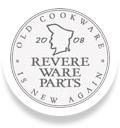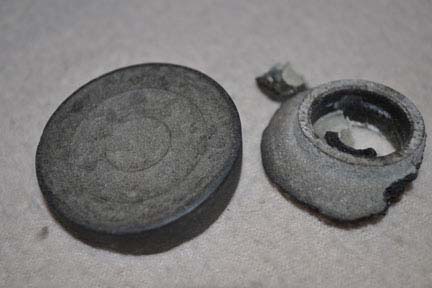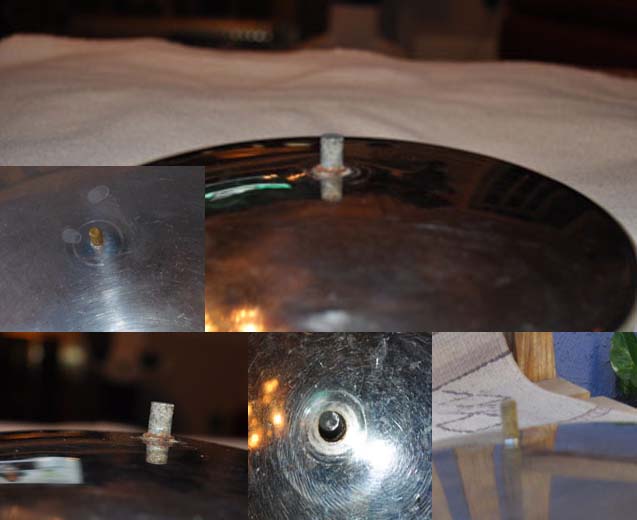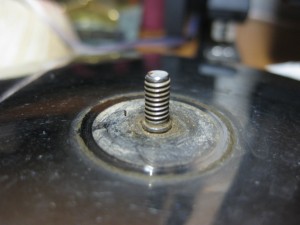One of the most common questions we get from customers is related to their lid not having a screw, but what appears to be a stub of some kind.
Over the years, as evidenced by the many differently constructed lid knobs we have come across, Revere Ware has used no threaded insert in the lid knobs (threads are part of the Bakelite) and threaded inserts of various types of metal, such as aluminum, brass, and possibly others.
The problem is that after years and years of use, the metal inserts often rust to the screw on the lid knob and the knob will either disintegrate when you try and take it off, will fall off leaving the insert behind, or when you try to unscrew it, the insert will stay attached to the screw. What is left looks like this:
The stub can also appear black as there might be Bakelite attached to it.
Some customers inherited a lid looking like this and others just assume that the knob is glued on to this stub and when they receive ours, with a threaded insert, think they’ve received the wrong kind of knob.
If you grab the insert with pliers and unscrew it, it will usually come right off, revealing the screw. If the nut insert doesn’t want to budge, try squirting some WD-40 at the crack where the nut comes close to the lid and letting it sit for a while. Heating the lid slightly at the point of the knob screw from underneath (such as placing it over a low gas flame) might also help loosen a stubborn nut and screw.
In some cases, perhaps one out of four, the rust bond will be too strong and the screw will break off. If that happens, here are instructions for attaching your knob with a separate screw.
Update: Reader Rick posted this helpful suggestion (below):
If the knob has already broken away from the insert, and the threads in the insert are too corroded to remove from the stud, you can to to step 2.
1) Using a hacksaw, carefully cut right down the center of the knob until you reach the insert. Do a second cut at right angles to the first. Using two flat bladed screw drivers at opposite sides of a cut line, pry the knob and it will crack and fall away from the insert. Not very much pressure is required.
2) Again with the hacksaw, carefully cut a slot in the center of the insert until you reach a void spot in the center of the insert. The void is there because the stud does not go all the way to the end of the threaded portion of the insert. Spray or drip in some penetrating oil, and let sit for a few hours. Try removing the insert with a pair of vice grips. This has worked perfectly a number of times for me.
Reader Fred posted a picture of his nut insert after using the hack saw.





I bought a cookware set back in the early 70s. I dropped my 4 quart saucepan and the complete handle fell off. My husband thinks Revere used some kind of glue/epoxy. I thought it had to have been welded or something. Any ideas? Thanks
The handles are connected to the pots via spot welding. In spot welding, a high voltage is passed from the inside of the pot to the outside of the handle base and the heat from the electrical current joins the two pieces of metal.
But they can fail as you have discovered.
Luckily, there is a very healthy market for used Revere Ware on eBay. You can easily find a suitable replacement for almost any piece.
It is possible to repair the spot weld if you take it to a machine shop or weld shop, but it probably won’t look as nice as it did and it is probably cheaper to pick up a replacement piece.
thanks so much for this info. I received my knobs and thought there is no way this fits. Great info…the screw on my pan was half there but had enough for the knob to be screwed on. Revere Ware is simply the best and it’s great to have this info. Appreciate your help !
Thanks, it worked. Revere is a good product run by a company that cares about its customers. Maybe that’s why they have such an excellent reputation and been in business for a number of years; Keep up the good work and thanks again for your prompt attention to this matter.
Well, at some time, that was true. The Revere Ware brand is now owned by World Kitchen LLC (who also owns Corning Ware and Pyrex) and generally produces lower quality products, no support for older products, and doesn’t sell any replacement parts. We are a separate business that has taken up the slack in supplying replacement parts that are no longer supplied by them.
I have a ReverWare 8inch saucepan lid that the handle is missing. I see no evidence of a screw penetrating the lid. Can I purchase a handle that would be adhesed to the top? Or do I need to drill a hole and replace it with a screw retained handle?
No, there is no such thing as that. You would need to drill a hole and use a separate screw to hold the knob to the lid. You can still use one of our knobs, you would just need a screw that works with it, an 8-32 machine screw beween .25 and .35 inches in length.
I’ve found a method to remove the knob from the lid if it appears that it will twist off the weld stud because of corrosion between the stud and knob insert. I’d say that if the corrosion has reached this point, the knob needs replacing anyway, but beware that this method sacrifices the knob. If the knob has already broken away from the insert, and the threads in the insert are too corroded to remove from the stud, you can to to step 2.
1) Using a hacksaw, carefully cut right down the center of the knob until you reach the insert. Do a second cut at right angles to the first. Using two flat bladed screw drivers at opposite sides of a cut line, pry the knob and it will crack and fall away from the insert. Not very much pressure is required.
2) Again with the hacksaw, carefully cut a slot in the center of the insert until you reach a void spot in the center of the insert. The void is there because the stud does not go all the way to the end of the threaded portion of the insert. Spray or drip in some penetrating oil, and let sit for a few hours. Try removing the insert with a pair of vice grips. This has worked perfectly a number of times for me.
Very helpful, thanks.
Great explanation and pics which assisted with removal of the stud that surrounded the treaded screw. I can now purchase a new knob and repair my vintage pan. Great job !!!
Rick — Your method works great! The void was right there, as you said. I didn’t want to go too far, so I made only a small hole. Applying the oil, it didn’t really want to go down the hole. But a few well-administered pats-on-the-back (of the lid), and it found its way in. An hour later, the channel-locks got the old insert off and the screw looks good.
I think the screw is 1/4 inche size if the pot brand is from U.K, U.S or Canada.
I own perhaps 40 lids myself. I have never seen a 1/4″ screw on a lid. I have never seen a picture of a screw that large. If you see something 1/4″ it is almost certainly the old nut insert, not a screw.
Thanks, Fred Myers, for the helpful picture. A few licks with the hacksaw, a couple of drops of Liquid Wrench, and Bob’s your uncle!